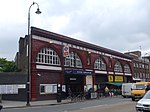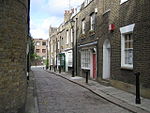The Pineapple, Kentish Town
Grade II listed buildings in the London Borough of CamdenGrade II listed pubs in LondonKentish TownPub stubsPubs in the London Borough of Camden ... and 1 more
Use British English from June 2014

The Pineapple is a Grade II listed public house at 51 Leverton Street, Kentish Town, London.It was built in about 1868.Its resident cat was called Spongebob.
Excerpt from the Wikipedia article The Pineapple, Kentish Town (License: CC BY-SA 3.0, Authors, Images).The Pineapple, Kentish Town
Leverton Street, London Tufnell Park (London Borough of Camden)
Geographical coordinates (GPS) Address Nearby Places Show on map
Geographical coordinates (GPS)
| Latitude | Longitude |
|---|---|
| N 51.552983 ° | E -0.1397009 ° |
Address
Leverton Street 51
NW5 2QD London, Tufnell Park (London Borough of Camden)
England, United Kingdom
Open on Google Maps









